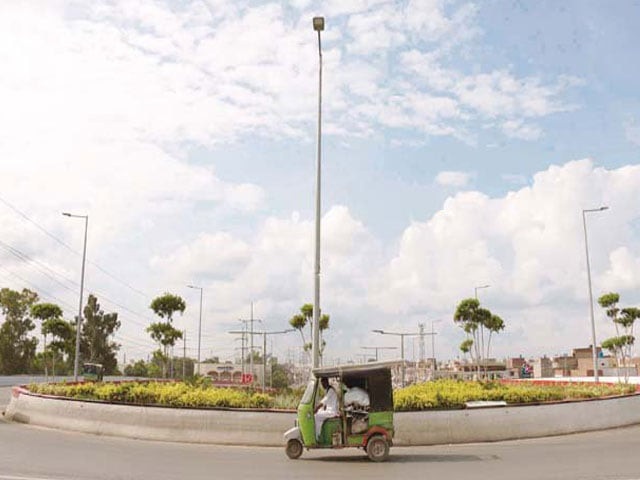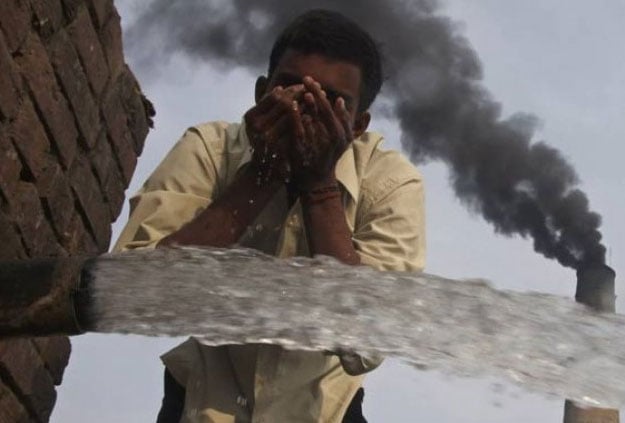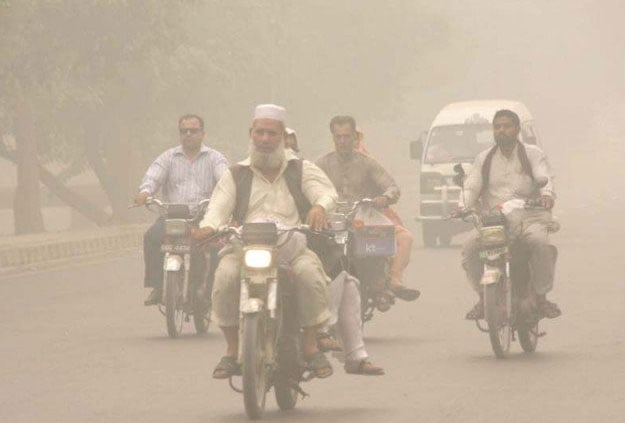Lahore is changing but surely not for good
Natural resources in the walled city are literally dying, calling for prompt measures to use them sustainably

Natural resources in the walled city are literally dying, calling for prompt measures to use them sustainably. PHOTO: SHAFIQ MALIK
Karachi’s population was at the highest from 9.34 million in 1998 to 14.91 million in 2017 – an increase of almost 60 per cent. Surprisingly, Lahore’s population had swelled to 11.13 million from 5.14 million – showing a staggering increase of 116.3 per cent.
Lahore — world’s largest city in 2050
Environmentalists regard population bulge as the biggest factor creating immense pressure on Lahore’s natural resources, thus calling for measures to use these finite resources sustainably.
Urban sprawl
The urban sprawl of Lahore is largely encroaching upon the natural resources. The Master Plan 2021 gave detailed reasons behind it, especially the population expansion factor that is threatening the natural environment of the city. The plan initially ensured food security by declaring various areas as agricultural zones on March 01, 2013. However, through a notification on June 13, 2013, the prime agricultural lands were converted into residential areas – a move that compromised the entire plan and threatened Lahore’s food security.
 In 2005 (L), the land cover was 32,729 hectares, in 2010 (C), the land cover was 37,095 hectares and in 2015 (R), the land cover was 39,681 hectares. PHOTO: Mapped and processed by Shahid Khawaja, Geopsatial Services Canada. Data source: © ESA Climate Change Initiative - Land Cover led by UCLouvain (2017)
In 2005 (L), the land cover was 32,729 hectares, in 2010 (C), the land cover was 37,095 hectares and in 2015 (R), the land cover was 39,681 hectares. PHOTO: Mapped and processed by Shahid Khawaja, Geopsatial Services Canada. Data source: © ESA Climate Change Initiative - Land Cover led by UCLouvain (2017)While monitoring Lahore’s urban sprawl from remote sensing data, it was revealed that from 1996 to 2015, the urban areas have tremendously increased and encroached upon croplands or tree cover. The Atlas of Urban Expansion, a significant tool to monitor the qualitative and quantitative aspects of global urban expansion, has given similar statistics about the walled city’s exploding population and its urban build up in 1991, 2000 and 2013.
Water situation
The water situation of Lahore is deteriorating with every passing day, as excessive groundwater abstraction is resulting into fast depletion and worsening of groundwater sources. A study published in the Science Advances journal in August titled ‘Extensive arsenic contamination in high-pH unconfined aquifers in the Indus Valley’ has testified that the groundwater of Indus Plain is heavily being tainted with arsenic, which exceeds 10 microgrammes per litre safe limit of World Health Organisation (WHO) and 50 microgrammes per litre limit by the government of Pakistan.
The report also highlights that approximately 50-60 million people in the country are using arsenic-tainted groundwater, with hot spots around Lahore and Hyderabad. In Lahore, over 1,000 persons per square kilometre are at risk from arsenic poisoning.
 A labourer drinks water as smokes rise from a chimney of a brick factory. PHOTO: REUTERS
A labourer drinks water as smokes rise from a chimney of a brick factory. PHOTO: REUTERSThe study warns regarding the health implications of arsenic-polluted groundwater causing skin disorders, lung cancer and heart diseases. Furthermore, arsenic also affects agricultural output, thus putting lives of millions at risk. It was further revealed that remediation in the municipal water supply system of Lahore is moderately effective in reducing arsenic levels, as 57 per cent of samples were found below 50 mg/litre and only one per cent of the samples were found safe.
Water crisis may soon hit major Pakistan cities
The CEO World Wide Fund for Nature-Pakistan (WWF-Pakistan), Hammad Naqi Khan expressed disappointment on the exploitation of groundwater resources of Lahore. He referred to WWF-Pakistan’s Situation Analysis of the Water Resources of Lahore report, which shares a grim picture of the city’s fast depleting groundwater, leaving no other option for Water and Sanitation Agency (WASA) but to pump potable water at a greater depth of 800 feet – a futile exercise, as shallow groundwater is not fit for human consumption.
“Increase in concrete structures is leading to wastage of rainwater because housing colonies and other commercial and infrastructure development projects are not adhering to green spaces and similar bylaws. When it rains and there is a flash flood, due to more concrete and paved roads, the system becomes choked and rainwater is wasted in sewers, which could otherwise have added to groundwater recharge.”
Air pollution
A recent World Bank’s report titled Cleaning Pakistan’s Air – Policy Options to Address the Cost of Outdoor Air Pollution has warned that the levels of air pollution above Lahore has high levels of Particulate Matter (PM2.5) ranging from 2 to 14 times higher than the United Nations Environmental Protection Agency (ESEPA)’s prescribed limits.
 Motorists drive through a thick blanket of fog early in the morning. PHOTO: APP
Motorists drive through a thick blanket of fog early in the morning. PHOTO: APPThe report cited emissions from vehicles, biomass and coal burning and industrial pollution as reasons for the surge in air pollution. It also noted that in the last decade, over 11 million cars appeared on the roads in Lahore, a growth of almost 30 per cent.
Air pollution has a direct link with human health as a recent World Health Organisation (WHO) report suggested air pollution as the primary reason for the deaths of almost 60,000 people alone in 2015. Lahore is also famous for being one of the worst cities in the world for smog. Another WHO 2016 report highlighted that the walled city was getting affected by air pollution, as the Fine Particulate Matter of 2.5 microns or less (PM2.5) ranges between 60-99 in Lahore.
Mass transit projects increasing air pollution in Lahore
The biggest dilemma is that not sufficient air quality monitoring devices to monitor air pollution are available with the government and if some devices are even measuring it, their stats are not shared with the public. With temperatures dropping down, Lahore gets the feeler of smog and no one knows what it contains.
For the last few years, smog has become a phenomenon for people in Lahore. In 2016, India was blamed for exacerbating smog in Pakistan due to the burning of paddy residue and its Diwali festival but this time Section-144 is imposed in various Indian states against the crop burning. In addition, the Indian Supreme Court has banned the sale of fireworks in New Delhi during Diwali to tackle air pollution. Nevertheless, if it could be established that crop burning in India exacerbated smog in Pakistan, then according to the International Environmental Law, India can be asked to prevent this from happening again.
Particulate Matter 2.5 (PM2.5) and Particulate Matter 10 (PM10) are dust matters, that can enter the blood as the lungs cannot filter them.
Lahore needs to learn from the Great Smog of 1952 of London, which persisted for mere five days, and led to 4,000 deaths, with some speculating as high as 12,000.
Urban forest cover
More than half of the world’s population lives in towns and big cities and it is expected that the number of people in urban areas will increase by 70 per cent until 2050.
 In 2007 (L), urban forest cover was 12359.71 hectares, in 2010 (C), urban forest cover was 7965.28 hectares and in 2015 (R), urban forest cover was 3520.32 hectares. PHOTO: Mapped and processed by Shahid Khawaja, Geopsatial Services Canada. Data source: © ESA Climate Change Initiative - Land Cover led by UCLouvain (2017)
In 2007 (L), urban forest cover was 12359.71 hectares, in 2010 (C), urban forest cover was 7965.28 hectares and in 2015 (R), urban forest cover was 3520.32 hectares. PHOTO: Mapped and processed by Shahid Khawaja, Geopsatial Services Canada. Data source: © ESA Climate Change Initiative - Land Cover led by UCLouvain (2017)“Though cities cover only two per cent of the earth’s surface, they produce more than 70 per cent of the greenhouse gas emissions (GHGs). Lahore needs to be a resilient city if it is to save its people from the impacts of climate change,” said Tahir Rasheed, CEO South Punjab Forest Company (SPFC).
“Lahore should take drastic measures to improve its forest cover, which is somewhere around five per cent and extremely low as compared to New York (up to 20.9 per cent), Delhi (up to 20.08 per cent) and Berlin (up to 45 per cent).”
Green ideas: Collaborating for the environment’s sake
Today, Lahore is being turned into a ‘Concrete Jungle’ with four-lane roads, multi-story buildings and ill-planned development projects, which are putting the remaining natural resources of the city at risk. The present government believes that they will be able to make Lahore greener again by planting Conocarpus – native to tropical regions of the world and other invasive species.
The walled city may be on the verge of exhausting its natural resources, however; the current government will not only be responsible for not solving the issue but also for multiplying the problems that the locals. Lahore is no more the ‘city of gardens’ but the ‘city of concrete’ and it is highly unlikely that the situation will change anytime soon.
Syed Muhammad Abubakar is an international award-winning environmental writer with an interest in climate change, deforestation, food security and sustainable development. He tweets @SyedMAbubakar and can be reached via s.m.abubakar@hotmail.com



















COMMENTS
Comments are moderated and generally will be posted if they are on-topic and not abusive.
For more information, please see our Comments FAQ